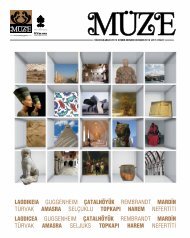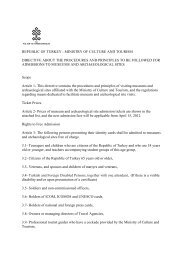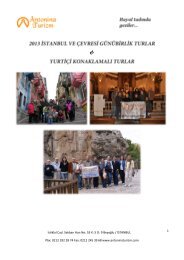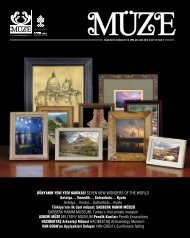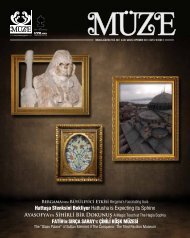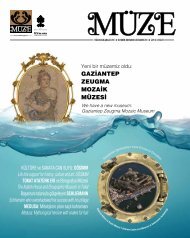TÃRK MÃZECÄ°LÄ°ÄÄ°NDE YENÄ° DÃNEM
TÃRK MÃZECÄ°LÄ°ÄÄ°NDE YENÄ° DÃNEM
TÃRK MÃZECÄ°LÄ°ÄÄ°NDE YENÄ° DÃNEM
You also want an ePaper? Increase the reach of your titles
YUMPU automatically turns print PDFs into web optimized ePapers that Google loves.
Parayla oynanan ilk oyunİki kişiyle oynanan bir şans ve yetenek oyunu olarak tanımlayabileceğimiztavlanın benzerlerinin M.Ö 3 bin ila bin 700 yılları arasındayaygın olarak oynandığına dair arkeolojik kalıntılar bulunuyor. Eneski kalıntılar, tavlanın atası olarak tanımlanabilecek ‘Senet’ denilenoyuna ait antik objeler... Bu objeler oyunun Antik Mısır ve Romadöneminde icat edilmiş olabileceğini gösteriyor. Tavla, Pers ve Hintİmparatorlukları, Sümer ve Roma medeniyetleri zamanında yaygınlaştı.Roma İmparatorluğu zamanında, ‘Tabula’ yani ‘Masa Oyunu’şeklinde Türkçe’ye çevrilebilecek bir oyuna dönüştü. Hayli popülerolan ‘Tabula’nın bu kadar çok sevilmesi ve yaygınlaşmasının nedenlerindenbiri de tarihte parayla oynanan ilk oyun olması.Hint ve Pers İmparatorları’nın birbirlerinin felsefi ve stratejikzekalarını tartmak için geliştirdiği sembol dili, tavlanın günümüzdeoynanan versiyonunun yaratılmasına neden oldu. Bu oyun, tabii kine İran ne de Hindistan ile sınırlı kaldı. Ticaret yolları sayesinde buküçük kutu ve içinde sakladığı sırlar Uzakdoğu’ya ulaştı, Arap işgaliyleGüney Avrupa’ya girdi. Haçlı seferleri de büyük yıkımlar ve haritadeğişiklerinin yanısıra pek çok kültürel öğeyle birlikte tavlayı daAvrupa’ya taşıdı. Yeni Dünya yani Amerika’nın keşfiyle birlikte medeniyetinolduğu her ülkeye ulaştı. Oyunun ismi yayıldığı ülkelere görefarklılık gösterse de tavla terimi, 1645 yılında bir İngiliz tarafındanüretildi. Araştırmacılar, terimin Sakson dilinden türetildiğini ve ‘gerioyun’ anlamına geldiğini ileri sürüyorlar.enc-ü se, severler güzeli gencüse sözünü bilmeyen varmıdır bu topraklarda! Ama tavlanın tarihinin günümüzdenbin 400 sene öncesine dayandığını, antik kalıntılararasında mermer tavlalara ve zarlara rastlandığını, tavladakisayıların zamanı ve kaderi temsil ettiğini biliyormuydunuz?Zamana direnerek 21’nci yüzyıla ulaşan bu oyunun izini sürmek için tarihinkoridorlarında eğlenceli bir gezintiye ne dersiniz?Günümüzden tam bin 400 yıl önce Pers İmparatoru Neşirvan’ın sarayında birgün... Azametli imparator Neşirvan, kendisine Hint İmparatoru tarafından birmektup ile birlikte gönderilen ve 64 kare üzerine yerleştirilen taşlarla oynanansatrancın sırrını çözmüş ancak yine de ne aklını ne de kalbini dinginleştirebilmiştir.Hint İmparatoru’nun mektubunda yazan, “Kim daha çok düşünüyor,kim daha iyi biliyor, kim daha ileriyi görüyorsa o kazanır... İşte hayat budur”sözlerine takılmıştır aklı imparatorun...En güvendiği Veziri Buhur Mehir’i de yanına çağıran imparator, bir süre konuhakkında düşündükten sonra, Hint İmparatoru’na gönderilmek üzere bir oyunhazırlamasını ister... Ancak bu sıradan bir oyun olmamalıdır. En az karşı tarafıda kendisi kadar düşündürecek, strateji geliştirmeye itecek ve mesajını doğruverecek bir oyun olmalıdır.60First game played for moneyIt is not uncommon, based on archaeological evidence, to trace backto the period between 3000 and 1700 B.C. the widespread practice ofdifferent varieties of this game which can be described as a game ofluck and ability played between two persons. The oldest items foundbelong to a game called Senet which can be considered as theforefather of backgammon. During the time of the Persian Empire,backgammon became popular in Mesopotamia under the Sumerians.Tabula - table game is another version of it practiced during the timeof the Roman Empire. The widespread popularity of tabula isprobably to explain, among other, with the fact that it was the firstgame of chance played for money, first example of gambling inhistory. The symbols’ language originating from a competitionbetween two emperors who wanted to test their abilities in the fieldof philosophy and strategy led to the creation of backgammon, whichdid neither remain confined to the borders of Persia nor to theborders of India. The box and its secrets travelled first to the far Eastthrough trade routes, reached southern Europe through Arab culture.The Crusades, on the one hand, caused extensive suffering anddestruction, on the other hand, they were the occasion for variouscultural features of the Orient, including backgammon, to reachwestern Europe. Later, following America’s discovery, the New Worldalso came to know this famous game and finally, the whole civilizedworld became acquainted with backgammon, nowadays a universalgame. Its name varies from one region or country to the other.However, according to researchers, the term backgammon wasprobably forged in 1645 from Saxon language by an Englishman andmeant, understandably, back game.“Penc ü se, severler güzeli gencüse” (approximate translation: five and three,to love beauties when they are young is free) is a well-known popular Turkishrhyming expression which associates luck at dice with the love for youngbeauties. Did you know that the origin of backgammon goes back to 1400years in history, that backgammon tables carved in marble and marble dicewere found in ancient ruins, that each dice number at backgammon isrepresenting the rhythm of time and fate? Backgammon standing out againsttime, regained its former popularity in the 21 st century thanks, among other,to the widespread practice of internet backgammon. Let us now embark uponan entertaining excursion into the hallways of history to discover and followthe footsteps of this famous game. The following episode takes place, onethousand four hundred years ago, in the palace of Persian Emperor Neshirian.The august Emperor of Persia was successful in untangling the secrets ofchess, a game played with pieces placed on a 64 squares, which was sent tohim as a gift accompanied by a letter by the Emperor of India. Nevertheless,neither his mind nor his heart were appeased, because he was intrigued andchallenged by the following sentence from the letter of the Emperor of India:“The one who thinks more, who knows better, who has better foresight willwin... This is what is life all about.” Emperor Neshirian, after having givenin-depth consideration to the subject matter, calls to him his most trustedminister, Grand Vizier Buhur Mehir and asks him to invent a new game to bedelivered to the Emperor of India... However, this should not be an ordinarygame, but a game which will constitute as much food for thought as has beenthe case for him with chess, which will necessitate developing strategy andsend the right message to the Emperor of India.Message conveyed by the letterThe Vizier, following weeks of reflection, comes finally before the Emperorwith a small box in his hands, being now sure that he has devised a game inwhich he was able to wrap philosophy, mysticism and the proper message tobe conveyed to the Emperor of India... Neshirian is now satisfied and serene,after getting wise about all the things that this small box is hiding... It is histurn to send a letter to the Emperor of India, together with the game inventedby his Vizier he is so proud of... And, here below are the eloquent thoughts heincluded in that letter: “Yes, the one who thinks more, who knows better, whohas better foresight will win, but some luck will help.”Efes Müzesi’nde sergilenen taş tavlalar (sağ sayfa üstte) ve Efes Yamaçevleri’ne aitbir tavla masası. (sağ sayfa altta)Stone backgammon boards exhibited in the Ephesus Museum (right page, top) anda backgammon table from the Ephesus Slope Houses. (right page, below)



